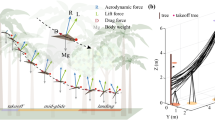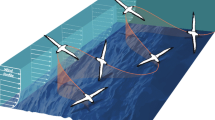Summary
-
1.
High speed film of naturally flyingLocusta migratoria has revealed gliding in these animals.
-
2.
Glides last from a few milliseconds up to about one third of a second.
-
3.
The glide always starts when the forewings reach the top of their stroke; the hindwings stop at the same instant although they have already started their downstroke.
-
4.
The basic wing positions during the glide are described.
-
5.
A lift drag ratio of 1.7∶1 has been calculated, and a minimum sinking rate of just over 2 m/s has been measured.
-
6.
Glides commence with a positive body angle of up to 30° but this is rapidly reduced during the glide as the animal pitches forward.
-
7.
Glides tend to end when the animal is diving, i.e. with a negative body angle.
-
8.
The end of a glide is heralded by the hindwings moving downwards, followed by the forewings. Body angles are restored to a positive value very quickly after the end of a glide.
Similar content being viewed by others
References
Baker, P.S., Cooter, R.J.: The natural flight of the Migratory Locust,Locusta migratoria L. I. Wing movements. J. Comp. Physiol.131, 79–87 (1979)
Bentley, D.R.: Intracellular activity in cricket neurons during the generation of behaviour patterns. J. Insect Physiol.15, 677–699 (1969)
Burrows, M.: The role of delayed excitation in the co-ordination of some metathoracic flight motoneurons of a locust. J. Comp. Physiol.83, 135–164 (1973)
Burrows, M.: Monosynaptic connections between wing stretch receptors and flight motorneurons of the locust. J. Exp. Biol.62, 189–219 (1975)
Jensen, M.: Biology and physics of locust flight. III. The aerodynamics of locust flight. Phil. Trans. R. Soc. B239, 511–552 (1956)
Kennedy, J.S.: The migration of the desert locust (Schistocerca gregaria). I. The behaviour of swarms. II. A theory of long-range migration. Phil. Trans. R. Soc. B235, 349–370 (1951)
Le Page, W.L.: Wind channel experiments on a pariah kite. J. R. Aeronaut. Soc.27, 114–115 (1923)
Miller, P.L.: Rhythmic activities and the insect nervous system. In: Experimental analysis of insect behaviour. Barton Browne, L., (ed.), pp. 114–138. Berlin, Heidelberg, New York: Springer 1974
Parrot, G.C.: Aerodynamics of gliding flight of a black vultureCoragyps atratus J. Exp. Biol.53, 363–374 (1970)
Pennycuick, C.J.: Gliding flight of the fulmar petrel. J. Exp. Biol.37, 330–338 (1960)
Pennycuick, C.J.: A wind tunnel study of gliding flight in the pigeonColumba livia. J. Exp. Biol.49, 509–526 (1968)
Rainey, R.C.: Some observations on flying locusts and atmospheric turbulence in eastern Africa. Q. J. R. Met. Soc.84, 334–354 (1958)
Rainey, R.C., Waloff, Z.: Flying locusts and convection currents. Anti-Locust Bull.9, 51–70 (1951)
Raspet, A.: Performance measurements of a soaring bird. Aeronaut. Eng. Rev.9, 14–17 (1950)
Roffey, J.: Observations on gliding in the desert locust. Anim. Behav.11, 359–366 (1963)
Waldron, I.: Mechanisms for production of the motor output pattern in the flying locust. J. Exp. Biol.47, 213–228 (1967)
Waloff, Z., Rainey, R.C.: Field studies on factors affecting the displacements of desert locust swarms in eastern Africa. Anti-Locust Bull.9, 1–51 (1951)
Weis-Fogh, T.: Biology and physics of locust flight. II. Flight performance of the desert locust,Schistocerca gregaria. Phil. Trans. R. Soc. B239, 459–510 (1956)
Author information
Authors and Affiliations
Additional information
We thank Dr. R.F. Chapman, Prof. M. Gewecke and Dr. P.L. Millerfor critically reading the manuscript. The field observations were made possible with generous assistance from the Department of Entomology, CSIRO, Canberra, and DASF, Bubia, Papua New Guinea. Special thanks are due to Dr. R.A. Farrow and sraff of the Locust Section, CSIRO.
Rights and permissions
About this article
Cite this article
Baker, P.S., Cooter, R.J. The natural flight of the migratory locust,Locusta migratoria L.. J. Comp. Physiol. 131, 89–94 (1979). https://doi.org/10.1007/BF00613087
Accepted:
Issue Date:
DOI: https://doi.org/10.1007/BF00613087




